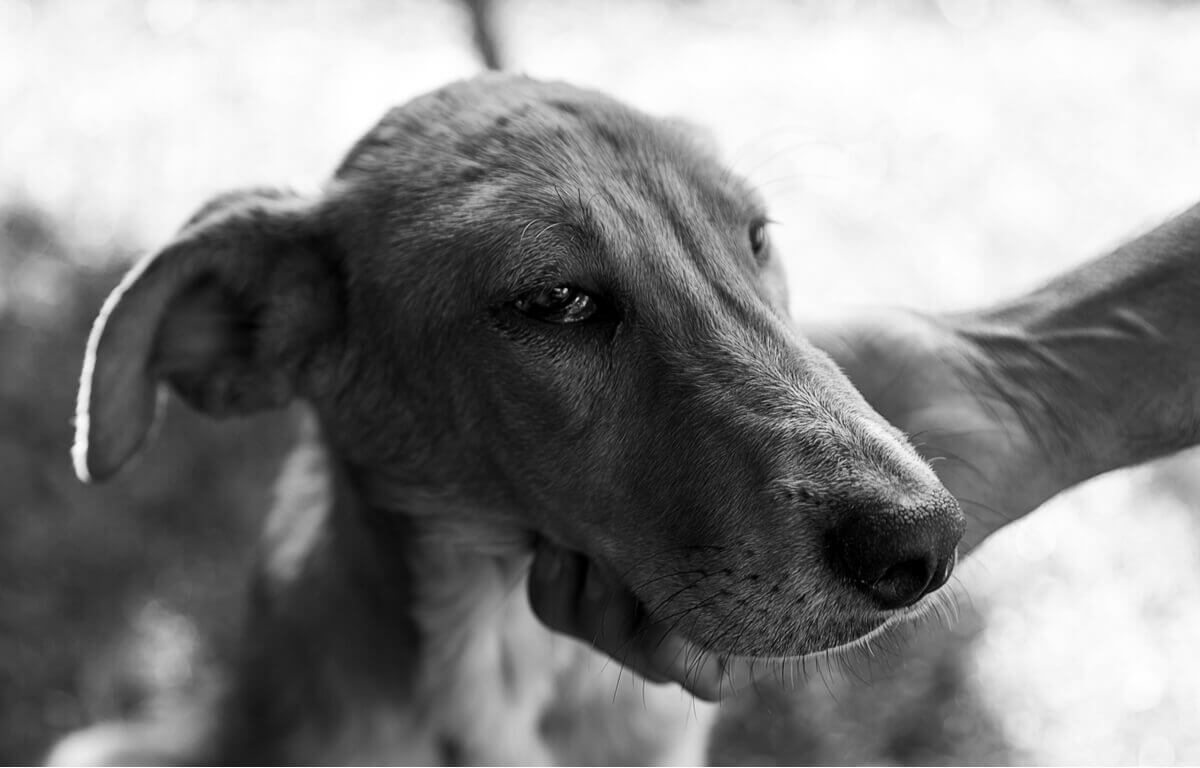10 Signs that a Dog is Dying


Written and verified by the biologist Samuel Sanchez
Unfortunately, nothing in life lasts forever. Organic matter decomposes. A being is considered “alive” if it’s breathing and living, and pet dogs are no exception to this rule. This is why we decided to write this article about ten signs that could indicate that, sadly, a dog is dying.
On many occasions, the owner will never see these signs in their dog, as it may already be admitted to a veterinary clinic. If death is near, the vet in charge of the animal will notify its owner so that both can say goodbye. As heartbreaking as it is, death is part of life.
What are the signs that could indicate a dog is dying?
Death is a terminal effect that results from the homeostatic process of the body of any living being ending. This event can occur due to natural causes, such as old age, disease, or predation, or it can be induced, due to traffic accidents, environmental disasters, euthanasia, and homicide, among other causes.
In the case of dogs, most die of natural causes. However, many die earlier than expected from cancer or autoimmune diseases. Without further ado, we’ll now explain the 10 signs that indicate that a dog is dying.

1. Prolonged lethargy and disinterest
A dog sleeps about 12 to 14 hours a day, so it isn’t uncommon to see them resting. However, if the animal doesn’t respond to the stimuli that previously made it jump for joy, something may be really wrong with it, physiologically speaking. Another clear indication that a dog is dying is when it rests in a place where it didn’t before.
2. Loss of appetite
A loss of appetite in dogs is often caused by anxiety, depression, separation anxiety, and some diseases. This can be partial or total, which will determine the severity of the dog’s condition. A prolonged lack of appetite can be a sign of multi-organ failure in a dog, which can lead to its death.
3. Incontinence
Urinary incontinence in senior dogs is very common and can be caused by different factors. Over time, the muscles that surround a dog’s urinary system weaken and its nervous control over certain body parts can decrease. Thus, it’s normal for it to pee indoors or in places where it didn’t use to do it.
Incontinence in itself isn’t a medical sign that a dog is going to die. However, if it appears suddenly with some of the symptoms we mentioned above, your dog may, sadly, not have a lot of time left.
4. Labored breathing
Labored breathing and chronic coughing can indicate that a dog is dying. In some cases, this behavior indicates that its body’s homeostatic balance has been disrupted, causing the pulmonary alveoli to fill up with fluid. If the dog is old, the prognosis is very poor.
5. Vomiting
When an animal is near death, it’s usually unable to properly digest food. This will make it vomit, leading to weakness and dehydration, which are typical of serious diseases. If a dog vomits repeatedly and is unable to keep food down, it may be dying.
6. Dependent behaviors
As heartbreaking as it may sound, a dog that’s about to die may require extra petting and attention from its owner. Dogs trust their owners the most, which is why they usually seek their love to be able to leave this world in peace. Although death causes fear in all living beings, you need to be strong and take care of your pet.
7. Seizures
Abnormal electrical activity in the brain causes focal seizures. They can be preceded by severe trauma, poisoning, consumption of drugs, brain tumors, low blood sodium, and other physiological imbalances. Unfortunately, some of these conditions could lead to the dog’s death.
8. Changes in gum color
Whitish or gray gums is a sign of serious disease. For whatever reason, the blood isn’t properly reaching the dog’s organs, an issue that becomes evident in the animal’s oral tissue. Some of the common causes of this are anemia, internal bleeding, and low blood pressure, among other conditions.
9. Loss of coordination
This is another sign that could indicate that a dog is dying. When the animal’s nervous system fails, it may have trouble getting up and it’ll bump against walls and move in an uncoordinated manner. This is usually indicative of a serious condition.
10. Irritability
Dogs are animals. In the last moments of their life, their instincts may take over. If your dog has some of the aforementioned symptoms and doesn’t allow you to approach it, it may be because it feels in danger and it doesn’t want anyone to hurt it in its final moments.

The end of the road
Your dog dying signifies the end of their road, but not yours. Say goodbye to your pet, take your time, cry, and grieve. This is part of the process. There’s nothing wrong with being vulnerable after the loss of a pet.
With time, your pain will transform into memories, longing, and positive emotions. In the end, positive experiences are the ones that leave their mark, meaning your dog will always be with you in your memories, even if it can’t physically be with you.
Unfortunately, nothing in life lasts forever. Organic matter decomposes. A being is considered “alive” if it’s breathing and living, and pet dogs are no exception to this rule. This is why we decided to write this article about ten signs that could indicate that, sadly, a dog is dying.
On many occasions, the owner will never see these signs in their dog, as it may already be admitted to a veterinary clinic. If death is near, the vet in charge of the animal will notify its owner so that both can say goodbye. As heartbreaking as it is, death is part of life.
What are the signs that could indicate a dog is dying?
Death is a terminal effect that results from the homeostatic process of the body of any living being ending. This event can occur due to natural causes, such as old age, disease, or predation, or it can be induced, due to traffic accidents, environmental disasters, euthanasia, and homicide, among other causes.
In the case of dogs, most die of natural causes. However, many die earlier than expected from cancer or autoimmune diseases. Without further ado, we’ll now explain the 10 signs that indicate that a dog is dying.

1. Prolonged lethargy and disinterest
A dog sleeps about 12 to 14 hours a day, so it isn’t uncommon to see them resting. However, if the animal doesn’t respond to the stimuli that previously made it jump for joy, something may be really wrong with it, physiologically speaking. Another clear indication that a dog is dying is when it rests in a place where it didn’t before.
2. Loss of appetite
A loss of appetite in dogs is often caused by anxiety, depression, separation anxiety, and some diseases. This can be partial or total, which will determine the severity of the dog’s condition. A prolonged lack of appetite can be a sign of multi-organ failure in a dog, which can lead to its death.
3. Incontinence
Urinary incontinence in senior dogs is very common and can be caused by different factors. Over time, the muscles that surround a dog’s urinary system weaken and its nervous control over certain body parts can decrease. Thus, it’s normal for it to pee indoors or in places where it didn’t use to do it.
Incontinence in itself isn’t a medical sign that a dog is going to die. However, if it appears suddenly with some of the symptoms we mentioned above, your dog may, sadly, not have a lot of time left.
4. Labored breathing
Labored breathing and chronic coughing can indicate that a dog is dying. In some cases, this behavior indicates that its body’s homeostatic balance has been disrupted, causing the pulmonary alveoli to fill up with fluid. If the dog is old, the prognosis is very poor.
5. Vomiting
When an animal is near death, it’s usually unable to properly digest food. This will make it vomit, leading to weakness and dehydration, which are typical of serious diseases. If a dog vomits repeatedly and is unable to keep food down, it may be dying.
6. Dependent behaviors
As heartbreaking as it may sound, a dog that’s about to die may require extra petting and attention from its owner. Dogs trust their owners the most, which is why they usually seek their love to be able to leave this world in peace. Although death causes fear in all living beings, you need to be strong and take care of your pet.
7. Seizures
Abnormal electrical activity in the brain causes focal seizures. They can be preceded by severe trauma, poisoning, consumption of drugs, brain tumors, low blood sodium, and other physiological imbalances. Unfortunately, some of these conditions could lead to the dog’s death.
8. Changes in gum color
Whitish or gray gums is a sign of serious disease. For whatever reason, the blood isn’t properly reaching the dog’s organs, an issue that becomes evident in the animal’s oral tissue. Some of the common causes of this are anemia, internal bleeding, and low blood pressure, among other conditions.
9. Loss of coordination
This is another sign that could indicate that a dog is dying. When the animal’s nervous system fails, it may have trouble getting up and it’ll bump against walls and move in an uncoordinated manner. This is usually indicative of a serious condition.
10. Irritability
Dogs are animals. In the last moments of their life, their instincts may take over. If your dog has some of the aforementioned symptoms and doesn’t allow you to approach it, it may be because it feels in danger and it doesn’t want anyone to hurt it in its final moments.

The end of the road
Your dog dying signifies the end of their road, but not yours. Say goodbye to your pet, take your time, cry, and grieve. This is part of the process. There’s nothing wrong with being vulnerable after the loss of a pet.
With time, your pain will transform into memories, longing, and positive emotions. In the end, positive experiences are the ones that leave their mark, meaning your dog will always be with you in your memories, even if it can’t physically be with you.
All cited sources were thoroughly reviewed by our team to ensure their quality, reliability, currency, and validity. The bibliography of this article was considered reliable and of academic or scientific accuracy.
- Brusa, M. (2014) Compendio de enfermedades de los caninos y felinos domésticos. Facultad de Ciencias Veterinarias. Recuperado el 4 de marzo de 2022, disponible en: https://core.ac.uk/download/pdf/20528361.pdf
- Eleni, C., Scholl, F., & Scaramozzino, P. (2014). Causes of death in dogs in the province of Rome (Italy). Veterinaria Italiana, 50(2), 137-143. https://europepmc.org/article/med/24981915
- Freitas, J. L., Andrade, T. S., Martins Filho, E. S., D’Soares, C. S., Souza, A. C. S. N., Silva, A. W. O., … & Peixoto, T. C. (2021). Causes of spontaneous death and euthanasia in dogs: A background study in Bahia, Brazil. Veterinární medicína, 66(4), 156-166. https://vetmed.agriculturejournals.cz/artkey/vet-202104-0004_causes-of-8239-spontaneous-death-and-euthanasia-in-8239-dogs-a-background-study-in-8239-bahia-brazil.php
- Meland, T., & Carrera-Justiz, S. (2018). A review: emergency management of dogs with suspected epileptic seizures. Topics in companion animal medicine, 33(1), 17-20. https://www.sciencedirect.com/science/article/abs/pii/S1938973618300035
- Bodizs, R., Kis, A., Gacsi, M., & Topal, J. (2020). Sleep in the dog: comparative, behavioral and translational relevance. Current Opinion in Behavioral Sciences, 33, 25-33. https://www.researchgate.net/publication/338159806_Sleep_in_the_dog_comparative_behavioral_and_translational_relevance
This text is provided for informational purposes only and does not replace consultation with a professional. If in doubt, consult your specialist.








